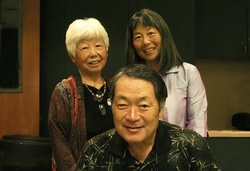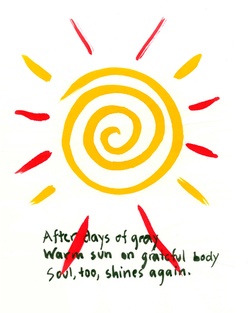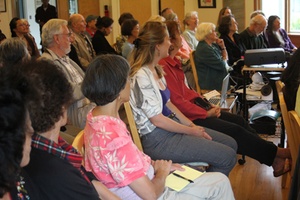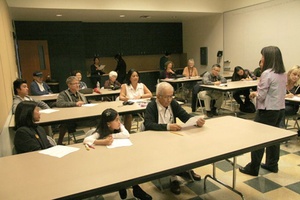A recent trip to Los Angeles to present at the Japanese American National Museum afforded me a glimpse into a culture in which I’m not often immersed—my own.
I live in the uppermost reaches of California, the real Northern California, not the San Francisco Bay area, which we North Coasters refer to as Central California. It’s a wilder region with more redwoods than people, a rocky and scenic coastline, and a notoriety borne out of its most recent export, marijuana. No, we are not all potheads up here, or old hippies.
Nor are we all Japanese Americans, or Asian Americans, that’s for certain. It’s an area that’s homogenous to a fault, and has a sordid history of chasing out Chinese Americans in the late nineteenth century, and not letting Asians return for nearly 60 years. Since then it’s become a much more mellow place, and very amenable in its acceptance of different cultures. But the Asian American community is small, and even smaller, the JA community. We have no local chapter of the JACL, we have no organized community, so when I proposed a project that would reach out to the Japanese American community in our area, it was somewhat of a quixotic quest.
My mother, Aiko Uyeki, wanted to assemble a collection of her mother’s senryu poetry. Senryu is haiku’s lesser-known cousin, a form that follows the same format as the haiku in its 5-7-5 syllable structure, but encompasses more subject matter, emotions and themes than the lofty nature- and spiritually-driven haiku. It originated in the 18th century, and was brought to California and the western U.S. by Issei immigrants who formed senryu poetry clubs up and down the coast in the 20th century. My grandmother, Shizue Harada, wrote under the pen name, Sanae, a moniker her senryu sensei gave her. Her poetry writing began after she retired in her 60s and continued until her death at age 94 in 1997. Many of Sanae’s poems reflect her strong Buddhist faith, her wry humor and simple wisdom, her musings about growing old and her approaching death.
I have used Sanae’s poems as inspiration for works of art—paintings, prints, and mixed media pieces—sporadically for nearly 20 years. My artwork can be conceived as a form of haiga, or poem painting, that can accompany a haiku or senryu and is also a Japanese cultural tradition stemming back to the 18th century. I wasn’t aware that I was practicing an ancient art when I responded in visual form to my grandmother’s poetry. I only knew that her poems were a catalyst for a visual dialogue, and that perhaps seeing both the poem and the artwork would enrich each other’s meaning.
When a good friend passed a grant application my way that supported projects that promoted sustaining cultures in California (the Alliance for California Traditional Arts Living Cultures Grants Program), I realized that what we wanted to do met the mission of this foundation, showcasing two traditional Japanese art forms, senryu writing and haiga artwork. One criterion of the grant is that information be disseminated to the community of the cultural tradition’s origin. In this case, it would be the Japanese American community in California. Our process would involve the publication of a book of Sanae’s senryu poetry with my haiga artwork (which became Sanae, Senryu Poet: Her Life in 5-7-5, The Poetry of Shizue Harada). This was to be followed by poetry readings and workshops around California, and online interaction with a web blog of readers’ and participants’ senryu and haiga.
Our first workshops and readings were held in Humboldt County where we live. We conducted three different readings and two workshops, all with attendance of from 60-80 people. For our first workshop, we made a special effort to contact and invite every JA and Japanese national we knew in our community to attend, and we were successful in reaching out to our small community. Our fourth reading/workshop was held at the Japanese American National Museum this November to a smaller but enthusiastic crowd. All the readings and workshops have been immensely satisfying because of the feedback and interaction of the participants. People are writing senryu and have incorporated it in their daily lives! Our submission pages are full of wry and witty, poignant and wistful, irreverent and goofy senryu from writers of all ages. The haiga images that have been submitted show a skillful blending of word and image, wonderful complements to each other. Some examples of both appear with this article.
Through press coverage and online blogs, our book has made it past the Redwood Curtain and I find myself making connections with the broader California Nikkei community—with artists, writers, poets, musicians and with others who all share a respect for different aspects of the Japanese culture. I have appreciated this opportunity to connect with a part of my heritage, and I have my grandmother—and my mother—to thank for this legacy of cultural traditions.
We are scheduled to do a reading and workshop in the San Francisco Bay area next year but have run into an interesting predicament: we have run out of books! We hope to find a publisher who will do a second printing of Sanae, Senryu Poet so that we can share the arts of senryu and haiga in the Bay area.
Some senryu from our workshops:
Memento she made
A napkin holder in use
Sweet Sanae, remembered—Michi Kondo
My passion, jazz hot!
Feelin’ great at eighty-eight!
Jazz, jazz, soulful jazz!No red envelope
In the mail today – Damn it!
Addiction: Netflix.—George Yoshida
Roomful of strangers
composing first senryu –
Gift from Sanae—May Mori
Kimono adorned
Dancing perfection beauty
Natori flowers—Christy Nakamine
Born second daughter
But a male heir was wanted.
Never good enough—Judy (Odagawa) Chan
Young, yet sensitive,
she saw strain between loved ones,
acted to mend it.—Gary Ono
Family silent
Shabu shabu pot bubbles
Warms body and soulThanksgiving dinner
Turkey, stuffing, and gohan...
all drowned in gravy!In my family
We join together and eat
Bonds formed around food—Vicky K. Murakami-Tsuda
Perfume: five bottles
Tee shirts for four days: thirteen.
Daughter packs for camp.Daughter, before camp:
But I’m not outdoorsy, I’m
indoorsy-mallsy!”My sweet warrior son
Stages swordfights, draws warships
Then snuggles in bed.—Annette Makino
Thinking in senryu
Distills essence of real life
Low fat expression.—Terry Uyeki
life through years as one
yet a span we dare not cross
i see you out there—Patty Saito-Hecht
These shoes on my feet
Many places to walk
Life is where I am.There is so much earth
So why so much hate over
Pieces of paper.—Parker Hecht, age 14
Home for the summer
Rendezvous with my sister
arranged through Facebook—Chisato Hughes
Post-World War II Senryu
A white linen suit
Pill-box hat upon her head
Stately she stands.Bowel of huge ship
Our blanket space together
Family now hopeful.Shock greets our return
Scenes of rubble and ashes
All are united.While our neighbors starve
Endowed with black market food
We survive the years.—Junko
And some of Sanae’s poems that were inspiration:
Drinking it, I know
Not drinking it, I don’t know:
The taste of sake.The remembrance of
My childhood hearth is the smell
Of sweet potatoes.Renting second floor,
I live up high but also
In neighbor’s backyard.Rouge camellia,
Even after wilting
Retains sexiness.Being wrapped and cared for
Reminds me I’m not wrapping
And caring for you.
We welcome any submissions of senryu or haiga to our website. Email us at azalea.books@gmail.com.
© 2010 Amy Uyeki






